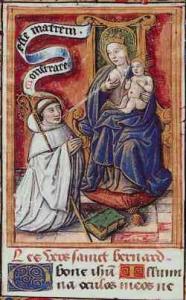While Jesus was speaking, a woman from the crowd called out and said to him, “Blessed is the womb that carried you and the breasts at which you nursed.” He replied, “Rather, blessed are those who hear the word of God and observe it.” –Luke 11:27-28
When the visiting priest from Nigeria read this Gospel passage on Wednesday night during the Vigil Mass for the Feast of the Assumption of the Blessed Virgin Mary, my children, standing beside me in the pew, looked up at me and grinned. Unpacking our belongings in our new home, we’ve come across photo albums I made when the kids were babies. My boys’ favorite snapshot captures them both nursing simultaneously. I sit on our black living room sofa gazing down at the new baby who’s latched on and tucked into my right elbow, his tiny arm outstretched to push big brother’s forehead away after he wiggled in under my left elbow and latched on the other side. Even now, at 7 and 9, they still push each other out of the way when one of them wants “Mama Time.”
******
There is an ancient devotion to the breastfeeding Virgin, or Our Lady of the Milk, dating to the earliest years of the Church. According to tradition, during the Slaughter of the Innocents, the Holy Family took refuge in an underground cave not far from the stable in Bethlehem. Before fleeing into Egypt with Joseph, the Blessed Mother nursed the Baby Jesus and a few drops of her breast milk fell onto the reddish-brown stones, rendering them creamy white. Around the corner from the Church of the Nativity and topped by a stone church that dates to 1838, the Milk Grotto is maintained by the Franciscan Custody of the Holy Land and annually draws tens of thousands of pilgrims.
Hilda Berkley of Bethlehem prays at a painting of Mary breastfeeding the infant Jesus at the Milk Grotto chapel in Bethlehem. RNS photo courtesy Debbie Hill/Catholic News Service.
Images and statues of a breastfeeding Virgin Mary, or “Maria Lactans” were once common religious art, illustrating how some in the Church considered her the “wet nurse of salvation.” Many believe that the devotion to Our Lady of the Milk is about 2000 years old, with the earliest known image of the Christ child suckling at his mother’s breast being a third century fresco in a catacomb in Rome.

The Virgin nursing her Child as a philosopher points to a star. Catacomb of Priscilla, Rome, c. 250 A.D.
“Milk shrines” and “lactation miracles” proliferated in the Middle Ages, with one popularly rendered image of St. Bernard of Clairvaux kneeling with folded hands, lips parted to receive breast milk that the Virgin squirts into his mouth. A theologian, preacher, and 12th century reformer of the Cistercian order, some argue that the key to his great wisdom was receiving the gift of the Blessed Mother’s milk.

Lactatio (milk wonder) of Bernhard of Clairvaux. From MS Douce 264, f.38v. in the Bodleian Library, Oxford.
According to Margaret Miles, a historian who traces the disappearance of the image of the breast-feeding Mary in A Complex Delight: The Secularization of the Breast, 1350-1750,” statues, paintings, and icons of the nursing Mary faded out by the eighteenth century. Even as Miles encountered the appearance of non-Christian paintings of breast-feeding women, she found no evidence of religious imagery of this subject after 1750. Scholars attribute the breastfeeding Madonna’s decline to the rise of the printing press and consequent adaptation of moveable type, which served to sensationalize women’s bodies, contesting the idea that the body reflected the divine. The rise of Protestantism with its rejection of both religious imagery and of Marian devotions shifted Catholic focus away from the succor available in Our Lady’s breasts to the solace provided by the crucified Christ’s ultimate sacrifice. Over time, many Catholics came to consider the breast as an unbefitting image for the House of God.
In the United States, devotion to Nuestra Señora de La Leche y Buen Parto, or Our Lady of the (Breast) Milk and Happy Delivery, as she came to be known, dates to the first Castilian colony in St. Augustine, Florida, the oldest continuously-inhabited city in the continental U.S. [Side note: my research site, Cholula, in the Mexican state of Puebla, is the oldest continuously-inhabited city in the Americas].

Statue of Nuestra Señora de La Leche y Buen Parto
National Shrine, St. Augustine, Florida
In early September 1565, explorer and commander Pedro Menéndez de Avilés led five ships commissioned by Philip II into a little cove along the coastline of what the Castilians were calling “La Florida,” or “the Flowery One.” Their two-month journey had been treacherous, involving winds so strong the men confessed their sins and sought absolution even as they threw overboard barrels of water, cooking materials, millstones, reserve rigging, and cables. Were it not for the chaplain of the fleet interceding for the men, the captain would have thrown all of the men’s belongings into the furious sea.
Upon landing, Menéndez planted a cross and claimed the land for Spain in the name of God, hence the mission now known as Nombre de Dios. Details of the journey come down to us from a biographical sketch penned by Menéndez’s companion and brother-in-law, Gonzalo Solís de Merás, as well as the journal of the aforementioned fleet chaplain, a Franciscan named fray Francisco López de Mendoza Grajales, who said the first Mass in the continental United States on a simple altar made of wood. It would be here, in what became the first Catholic parish in the U.S., that settlers introduced the popular Castilian devotion to Nuestra Señora de La Leche y Buen Parto. In 2019, the United States Conference of Catholic Bishops elevated the church to national shrine status, and in 2021 it received a papally-approved canonical coronation.

National Shrine of Our Lady of La Leche at Mission Nombre de Dios in St. Augustine, Florida
You can read the friar’s journal entry here, wherein he describes Castilian clashes with the French, Castilian capture of the French fort, and the execution of hundreds of Frenchmen for the crime of being Calvinists.
Lest you think this devotion is relegated to the past, not only are contemporary Latino Catholics keeping it alive, but there’s an active, international Facebook group with 10,000 followers dedicated to “La Virgen de la Leche y Buen Parto.” The group shares images of breastfeeding Virgin Marys and historical and devotional information, including an August 20, 2023 post explaining the symbolism of the image of St. Bernard of Clairvaux drinking the Virgin’s breast milk.
Despite being a life-long Catholic, a mom who meditated on the Virgin Mary’s motherhood during my four pregnancies, and a historian who studies Franciscans in the Americas in the sixteenth century, I somehow remained unfamiliar with the Lady of the Milk until now. In an effort to de-sensualize the breast for my sons and daughter and focus on the beautiful gift of feeding one’s children with one’s own body, I have shared with my little ones what I’ve learned about Nuestra Señora de La Leche. They love the idea that baby Jesus was just like them, suckling at the breast, sharing in the sweet milk, and even sweeter love, of his mother.

Castilian version of La Virgen de la Leche y Buen Parto
I think we’re going to find ourselves an image of Our Lady of the Milk nursing her Son and place it next to the image of me nursing my sons. United in motherhood. If only we could see the Virgin Mary in all nursing mothers. Let it begin with me.















